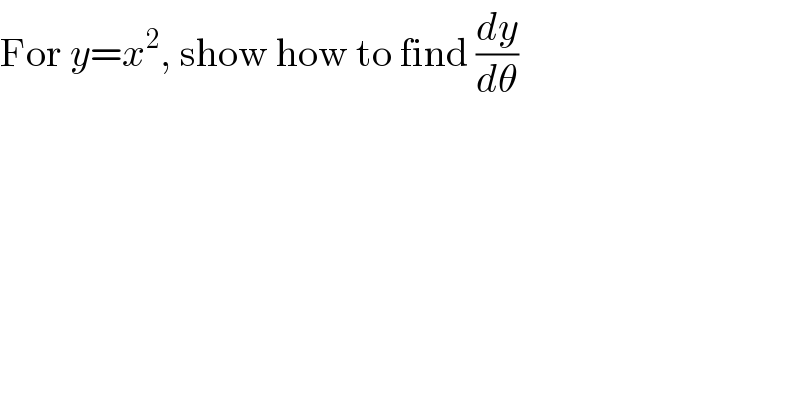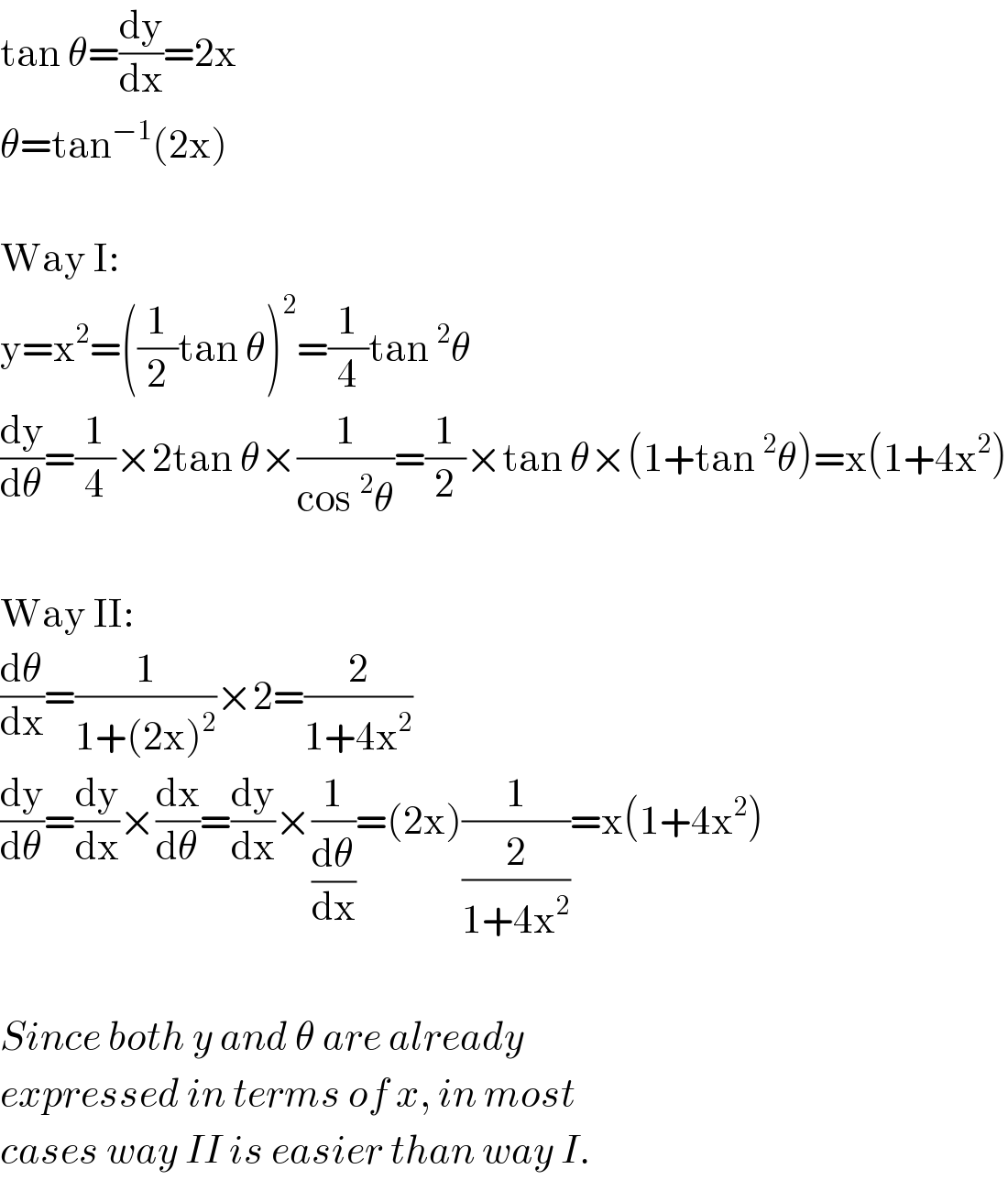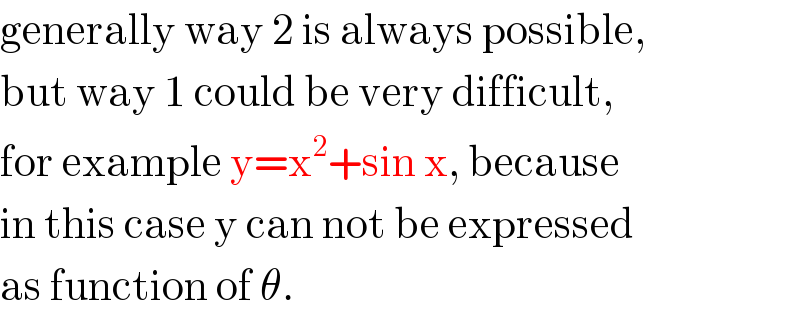Question Number 9498 by FilupSmith last updated on 11/Dec/16

$$\mathrm{For}\:{y}={x}^{\mathrm{2}} ,\:\mathrm{show}\:\mathrm{how}\:\mathrm{to}\:\mathrm{find}\:\frac{{dy}}{{d}\theta} \\ $$
Commented by FilupSmith last updated on 11/Dec/16

$$\mathrm{Note}:\:\theta\:\mathrm{is}\:\mathrm{the}\:\mathrm{angle}\:\mathrm{of}\:\mathrm{the}\:\mathrm{tangent}\:\mathrm{line} \\ $$
Answered by mrW last updated on 11/Dec/16

$$\mathrm{tan}\:\theta=\frac{\mathrm{dy}}{\mathrm{dx}}=\mathrm{2x} \\ $$$$\theta=\mathrm{tan}^{−\mathrm{1}} \left(\mathrm{2x}\right) \\ $$$$ \\ $$$$\mathrm{Way}\:\mathrm{I}: \\ $$$$\mathrm{y}=\mathrm{x}^{\mathrm{2}} =\left(\frac{\mathrm{1}}{\mathrm{2}}\mathrm{tan}\:\theta\right)^{\mathrm{2}} =\frac{\mathrm{1}}{\mathrm{4}}\mathrm{tan}\:^{\mathrm{2}} \theta \\ $$$$\frac{\mathrm{dy}}{\mathrm{d}\theta}=\frac{\mathrm{1}}{\mathrm{4}}×\mathrm{2tan}\:\theta×\frac{\mathrm{1}}{\mathrm{cos}\:^{\mathrm{2}} \theta}=\frac{\mathrm{1}}{\mathrm{2}}×\mathrm{tan}\:\theta×\left(\mathrm{1}+\mathrm{tan}\:^{\mathrm{2}} \theta\right)=\mathrm{x}\left(\mathrm{1}+\mathrm{4x}^{\mathrm{2}} \right) \\ $$$$ \\ $$$$\mathrm{Way}\:\mathrm{II}: \\ $$$$\frac{\mathrm{d}\theta}{\mathrm{dx}}=\frac{\mathrm{1}}{\mathrm{1}+\left(\mathrm{2x}\right)^{\mathrm{2}} }×\mathrm{2}=\frac{\mathrm{2}}{\mathrm{1}+\mathrm{4x}^{\mathrm{2}} } \\ $$$$\frac{\mathrm{dy}}{\mathrm{d}\theta}=\frac{\mathrm{dy}}{\mathrm{dx}}×\frac{\mathrm{dx}}{\mathrm{d}\theta}=\frac{\mathrm{dy}}{\mathrm{dx}}×\frac{\mathrm{1}}{\frac{\mathrm{d}\theta}{\mathrm{dx}}}=\left(\mathrm{2x}\right)\frac{\mathrm{1}}{\frac{\mathrm{2}}{\mathrm{1}+\mathrm{4x}^{\mathrm{2}} }}=\mathrm{x}\left(\mathrm{1}+\mathrm{4x}^{\mathrm{2}} \right) \\ $$$$ \\ $$$${Since}\:{both}\:{y}\:{and}\:\theta\:{are}\:{already}\: \\ $$$${expressed}\:{in}\:{terms}\:{of}\:{x},\:{in}\:{most} \\ $$$${cases}\:{way}\:{II}\:{is}\:{easier}\:{than}\:{way}\:{I}. \\ $$
Commented by FilupSmith last updated on 11/Dec/16

$$\mathrm{You}\:\mathrm{said}\:\mathrm{y}=\mathrm{2x}^{\mathrm{2}} \:\mathrm{in}\:\mathrm{Way}\:\mathrm{I}.\:\mathrm{Where}\:\mathrm{did} \\ $$$$\mathrm{the}\:\mathrm{2}\:\mathrm{come}\:\mathrm{from}? \\ $$
Commented by mrW last updated on 11/Dec/16

$$\mathrm{sorry},\:\mathrm{that}'\mathrm{s}\:\mathrm{my}\:\mathrm{mistake},\:\mathrm{I}'\mathrm{ll}\:\mathrm{correct}. \\ $$
Commented by mrW last updated on 11/Dec/16

$$\mathrm{errror}\:\mathrm{is}\:\mathrm{corrected}. \\ $$
Commented by FilupSmith last updated on 11/Dec/16

$$\mathrm{thanks}.\:\mathrm{i}\:\mathrm{find}\:\mathrm{wa}{y}\:\mathrm{1}\:\mathrm{easier} \\ $$
Commented by mrW last updated on 11/Dec/16

$$\mathrm{generally}\:\mathrm{way}\:\mathrm{2}\:\mathrm{is}\:\mathrm{always}\:\mathrm{possible}, \\ $$$$\mathrm{but}\:\mathrm{way}\:\mathrm{1}\:\mathrm{could}\:\mathrm{be}\:\mathrm{very}\:\mathrm{difficult}, \\ $$$$\mathrm{for}\:\mathrm{example}\:\mathrm{y}=\mathrm{x}^{\mathrm{2}} +\mathrm{sin}\:\mathrm{x},\:\mathrm{because} \\ $$$$\mathrm{in}\:\mathrm{this}\:\mathrm{case}\:\mathrm{y}\:\mathrm{can}\:\mathrm{not}\:\mathrm{be}\:\mathrm{expressed} \\ $$$$\mathrm{as}\:\mathrm{function}\:\mathrm{of}\:\theta. \\ $$
